
Harrisonburg is an independent city in the Shenandoah Valley region of the Commonwealth of Virginia in the United States. It is also the county seat of the surrounding Rockingham County, although the two are separate jurisdictions. At the 2020 census, the population was 51,814. The Bureau of Economic Analysis combines the city of Harrisonburg with Rockingham County for statistical purposes into the Harrisonburg, Virginia Metropolitan Statistical Area, which had an estimated population of 126,562 in 2011.

Alexandria National Cemetery is a United States National Cemetery, of approximately 5.5 acres (2.2 ha), located in the city of Alexandria, Virginia. Administered by the United States Department of Veterans Affairs, it is one of the original national cemeteries that were established in 1862. As of 2014, it was site to over 4,500 interments. The cemetery can accommodate the cremated remains of eligible individuals.
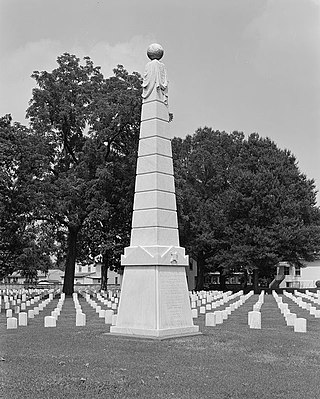
City Point National Cemetery is a United States National Cemetery in the community of City Point within the city of Hopewell, Virginia. Administered by the United States Department of Veterans Affairs, it encompasses 6.7 acres (2.7 ha), and as of the end of 2005, had 6,909 interments. It is managed by Hampton National Cemetery.
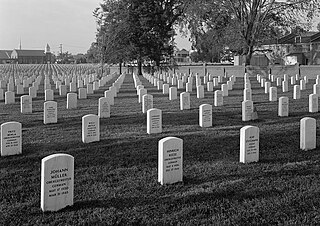
Hampton National Cemetery is a United States National Cemetery in the city of Hampton, Virginia. It encompasses 27.1 acres (11.0 ha), and as of 2014, had over 30,000 interments. There are two separate parts to this facility. The original cemetery is called the "Hampton Section" and is located on Cemetery Road in Hampton, VA. It is on the western side of I-64. The new section which is called the "Phoebus Addition" or the "Phoebus Section" West County Street in Hampton, VA east of I-64. It is less than a mile from the original cemetery. Both sections of the Hampton National Cemetery are closed to new interments.

Crown Hill National Cemetery is a U.S. National Cemetery located in Indianapolis, Marion County, Indiana. It was established in 1866 on Section 10 within Crown Hill Cemetery, a privately owned cemetery on the city's northwest side. Administered by the United States Department of Veterans Affairs, the National Cemetery encompasses 1.4 acres (0.57 ha) and serves as a burial site for Union soldiers who fought in the American Civil War.

Winchester National Cemetery is a United States National Cemetery located in the city of Winchester in Frederick County, Virginia. Administered by the United States Department of Veterans Affairs, it encompasses 4.9 acres (2.0 ha), and as of the end of 2005, it had 5,561 interments. It is closed to new interments.

Grafton National Cemetery is a United States National Cemetery located in Grafton, West Virginia. It encompasses a total of 3.2 acres (1.3 ha). Along with West Virginia National Cemetery, it is one of two United States Department of Veterans Affairs national cemeteries in West Virginia, both of which are located in Grafton. The first interments took place in 1867 for casualties of the American Civil War in West Virginia.

Danville National Cemetery is a United States National Cemetery located in the city of Danville, Virginia. Administered by the United States Department of Veterans Affairs, it encompasses 3.5 acres (1.4 ha) and, as of the end of 2005, it had 2,282 interments. It is managed by Salisbury National Cemetery.

The Hebrew Cemetery in Richmond, Virginia, also known as Hebrew Burying Ground, dates from 1816. This Jewish cemetery, one of the oldest in the United States, was founded in 1816 as successor to the Franklin Street Burial Grounds of 1789. Among those interred here is Josephine Cohen Joel, who was well known in the early 20th century as the founder of Richmond Art Co. Within Hebrew Cemetery is a plot known as the Soldier's Section. It contains the graves of 30 Jewish Confederate soldiers who died in or near Richmond. It is one of only two Jewish military cemeteries outside of the State of Israel.

Magnolia Cemetery is a historic city cemetery located in Mobile, Alabama. Filled with many elaborate Victorian-era monuments, it spans more than 100 acres (40 ha). It served as Mobile's primary, and almost exclusive, burial place during the 19th century. It is the final resting place for many of Mobile's 19th- and early 20th-century citizens. The cemetery is roughly bounded by Frye Street to the north, Gayle Street to the east, and Ann Street to the west. Virginia Street originally formed the southern border before the cemetery was expanded and now cuts east–west through the center of the cemetery. Magnolia contains more than 80,000 burials and remains an active, though very limited, burial site today.
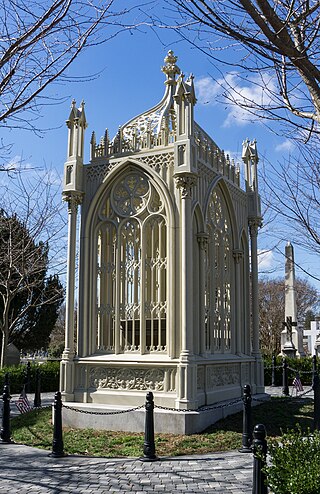
The James Monroe Tomb is the burial place of U.S. President James Monroe in Hollywood Cemetery, Richmond, Virginia, United States. The principal feature of the tomb is an architecturally unusual cast iron cage, designed by Albert Lybrock and installed in 1859 after Monroe's body was moved from Marble Cemetery in New York City. The tomb was declared a National Historic Landmark in 1971 for its unique architecture. To Richmonders it is colloquially known as The Birdcage.

This is a list of the National Register of Historic Places listings in Harrisonburg, Virginia.

Hatfield Cemetery is a historic cemetery located near Sarah Ann, Logan County, West Virginia. The earliest burial dates to 1898, and is the grave of Captain S. Hatfield (1891–1898). The cemetery features the grave and monument with a life-size statue of Captain Anderson "Devil Anse" Hatfield, erected in 1926. It is notable as a burial place for members of the Hatfield family, early settlers of the region and participants in the famous Hatfield-McCoy feud during the 19th century. It is a companion to the Hatfield Cemetery near Newtown, West Virginia.
Hatfield Cemetery is a historic cemetery located near Newtown, Mingo County, West Virginia. The earliest burial dates to 1881, and is the grave of Ephraim Hatfield. The cemetery contains over 100 burials including Ellison Hatfield, brother of Captain Anderson "Devil Anse" Hatfield, whose killing by three sons of Randolph McCoy at an election in Pike County, Kentucky, in 1882 is generally regarded as the beginning of the famous Hatfield-McCoy Feud. It is a companion to the Hatfield Cemetery near Sarah Ann, West Virginia.

The Oakland Cemetery is a 40-acre (16 ha) public cemetery maintained by the city of Fort Dodge, Iowa, United States. Property for the cemetery was set aside in 1859. It was laid out the same year by Egbert Bagg, an architect and civil engineer from Utica, New York. The graves and monuments are arranged around the natural contours of the hills that overlook Soldier Creek in a natural park-like setting. It is considered a good and rare example of a rural cemetery in North Central Iowa. It has been listed as an historic district on the National Register of Historic Places since 2000.
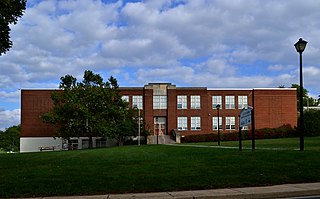
The Lucy F. Simms School is a school building at 620 Simms Avenue in Harrisonburg, Virginia. It was listed on the National Register of Historic Places on February 11, 2004. Lucy F. Simms was a former slave who went on to become an influential teacher in Harrisonburg.

Longs Chapel, also known as Old Athens Church and Athens Colored School, is a historic Church of the United Brethren in Christ church and cemetery located at Zenda near Harrisonburg, Rockingham County, Virginia. It was built about 1871, and is a small, one-story, frame structure with a standard gable-fronted nave form with weatherboard siding, metal roofing, stone foundation piers, a small belfry, and an apse added about 1900. It measures approximately 20 feet by 30 feet. The cemetery includes multiple grave depressions, fieldstone tombstones, and a number of professionally carved marble monuments. The church also housed a one-room school for African-American children where Harrisonburg educator Lucy F. Simms had her first teaching post in 1877. The school at Zenda closed in 1925 and the last services at Longs Chapel were held in the late 1920s. The building was subsequently used as a hay barn. The last burial was in 1935.

The Pioneer and Military Memorial Park is the official name given to seven historic cemeteries in Phoenix, Arizona. The cemeteries were founded in 1884 in what was known as "Block 32". On February 1, 2007, "Block 32" was renamed Pioneer and Military Memorial Park. The Pioneer and Military Memorial Park is listed in the National Register of Historic Places. The historic Smurthwaite House, which is also listed in the National Register of Historic Places, is located on the grounds of the Pioneer and Military Memorial Park and is used as the cemetery's main office. Pioneer and Military Memorial Park is the final resting place of various notable pioneers of Arizona.

The Hollywood Cemetery is the oldest cemetery in Hot Springs, Arkansas. The cemetery was established sometime prior to the American Civil War, with its oldest marked grave dating to 1856. It is located southeast of downtown Hot Springs, and is bounded by Hollywood Avenue, Mote Street, and Shady Grove Road. Its Confederate Section, located in the northeastern part of the cemetery, commemorates the city's Civil War Confederate Army soldiers, and contains 34 marked burials. At the center of that area is an 8-foot (2.4 m) granite monument in which is a marble marker inscribed "OUR CONFEDERATE DEAD". The Confederate section of the cemetery was listed on the National Register of Historic Places in 1996.
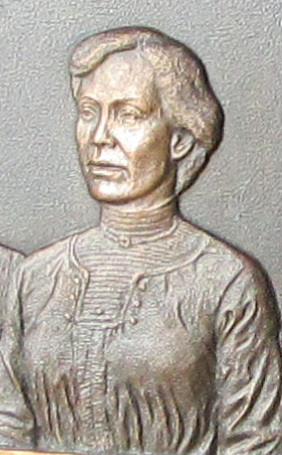
Lucy F. Simms was a former slave and educator who lived in Harrisonburg, Virginia, USA. She is one of those commemorated on the Emancipation and Freedom Monument in Richmond, Virginia.






















